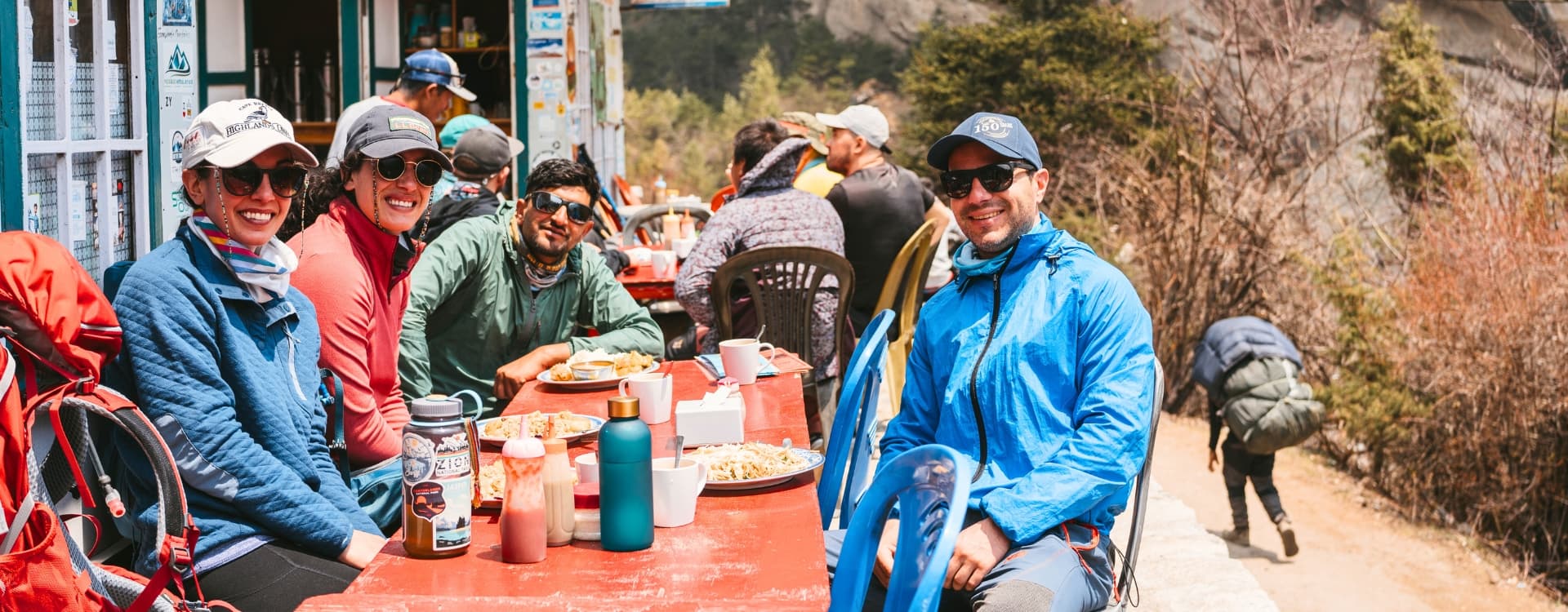Famous all over the world as one of the most amazing and adventurous trekking journeys on the planet- the Everest Base Camp Trek presents challenges pertaining to both the physical and mental aspect. The trekking journey is the one where trekkers have to adjust to high altitude conditions, adjust themselves at the accommodations in the mountains, and of course trek for prolonged hours during the day, hiking from one destination to the next. The Everest Base Camp Trek, while being one of the most beautiful trekking journeys out there, still presents certain challenges that take people out of their comfort zone. Here, we will be discussing about the food during the Everest Base Camp Trek-
Regular meals and food during the Everest Base Camp Trek are available at the lodges and the guesthouses where trekkers stay during the journey. It is important to know how to eat meals in accordance with your body’s needs in the mountains. The Everest Base Camp Trek is a relatively moderate trekking journey and enjoying a regular meal at the tea-houses or the trekking lodges would certainly suffice. In addition, taking easy-to-use nutritional supplements, vitamins and minerals along the trek also greatly helps. The meals and food during the Everest Base Camp Trek are prepared hygienically and make for good sources of energy.
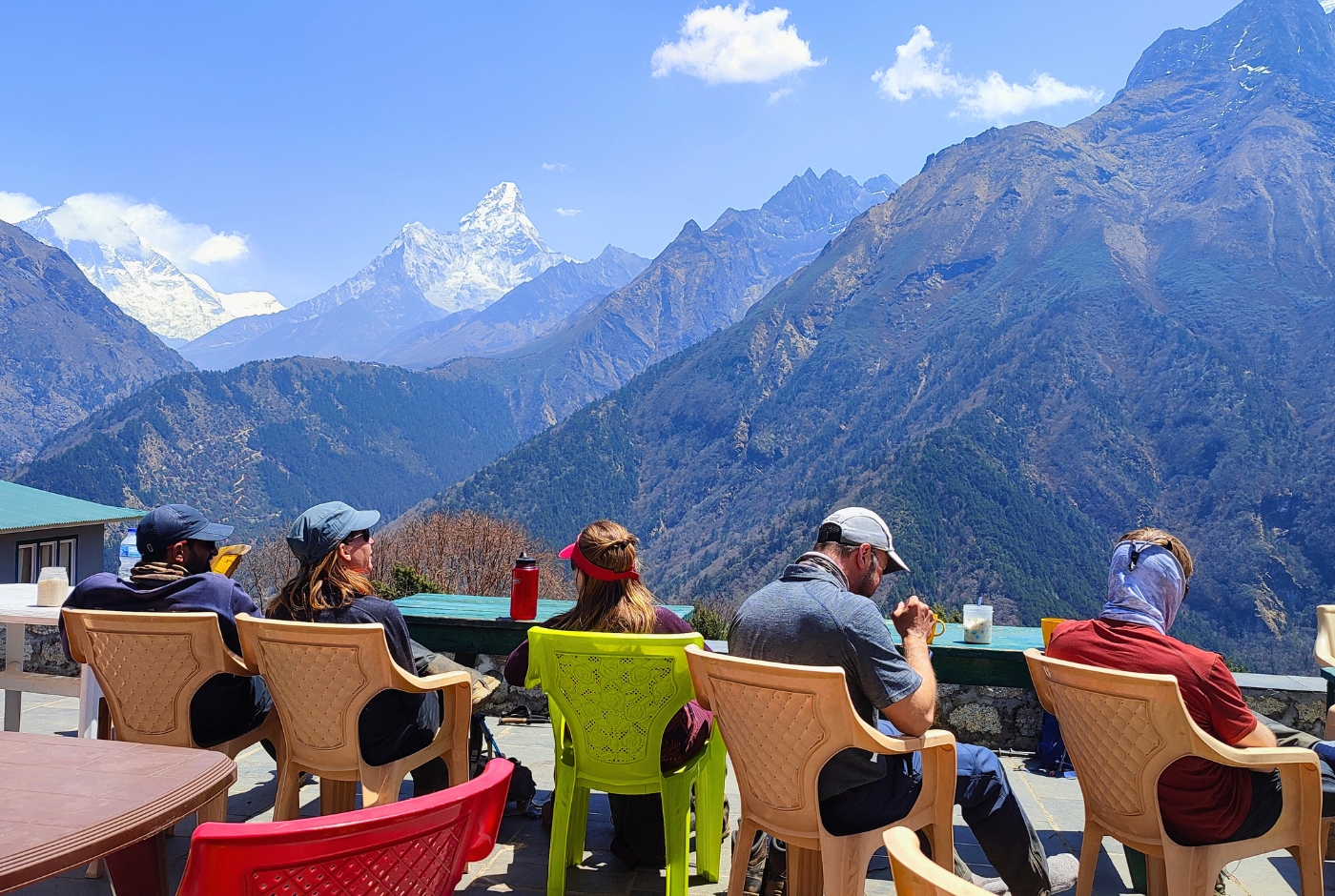
Generally, it is important to about certain aspects of culture of the people living in the mountains. The Sherpa people, who are the prominent people residing in the mountain villages, follow their tradition and custom of not slaughtering animals. The Buddhist religion does not condone killing animals, and thus the entire acreage under the Sagarmatha National Park does not allow any animals to be harmed. As such, meat and eggs for the Everest Base Camp Trek are generally supplied from Kathmandu. Because many villages along the trekking route to the Base Camp are located far away from any roads, getting the food supplies to the locations are done by planes. After that, the food is carried higher up in the mountains by porters, yaks and other domesticated animals of the mountains. This leads to higher prices of the food in the Himals. Basically, at remote locations during the trek, the food is brought with great strain by the porters from their aviation arrival points. During the Everest Base Camp Trek, the foods to the lodges arrive from Kathmandu to Lukla and are then carried further on by the porters and the animals.
For these reasons, the aspect of meals and food during the Everest Base Camp Trek isn’t extremely wide. Flour and cereal food products and meals are the ones that are readily available at the tea-houses and the lodges. It is also advised to stick to vegetarian meals rather than non-vegetarian meals because not all trekkers have the stomach for it at high altitude locations. One can certainly order meat dishes, but because of the transportation of the food in the mountain as mentioned before, the meat products do not tend to be the most fresh. Meat dishes can be ordered at trekking lodges that attract a large number of trekker as this pertains to a greater likelihood of the meat being fresh, but at remote locations while trekking, it is best to have vegetarian meals for this leads to fewer chances of having adverse effects.
Fish dishes are very unlikely to be available along the trekking routes. More expensive lodges and guesthouses might serve fish dishes but because of the region’s relative isolation, other simpler lodges might not serve fishes. Upon starting the trek, it is best to be properly acclimatized as well and to avoid any hard-to-process foods like heavy meat products and food rich in fat. Easily digestible foods that are light and provide energy are the best way to go. Staple food of the country- Dal Bhat (Rice and Lentils) is readily available everywhere is one of the best trekking foods to consume. Rice fills up the stomach contently and is eaten with vegetable curry and lentils, which are all great sources of energy.
Guesthouse and Lodge Food during the Everest Base Camp Trek
What kind of food is available on the Everest Base Camp Trek?
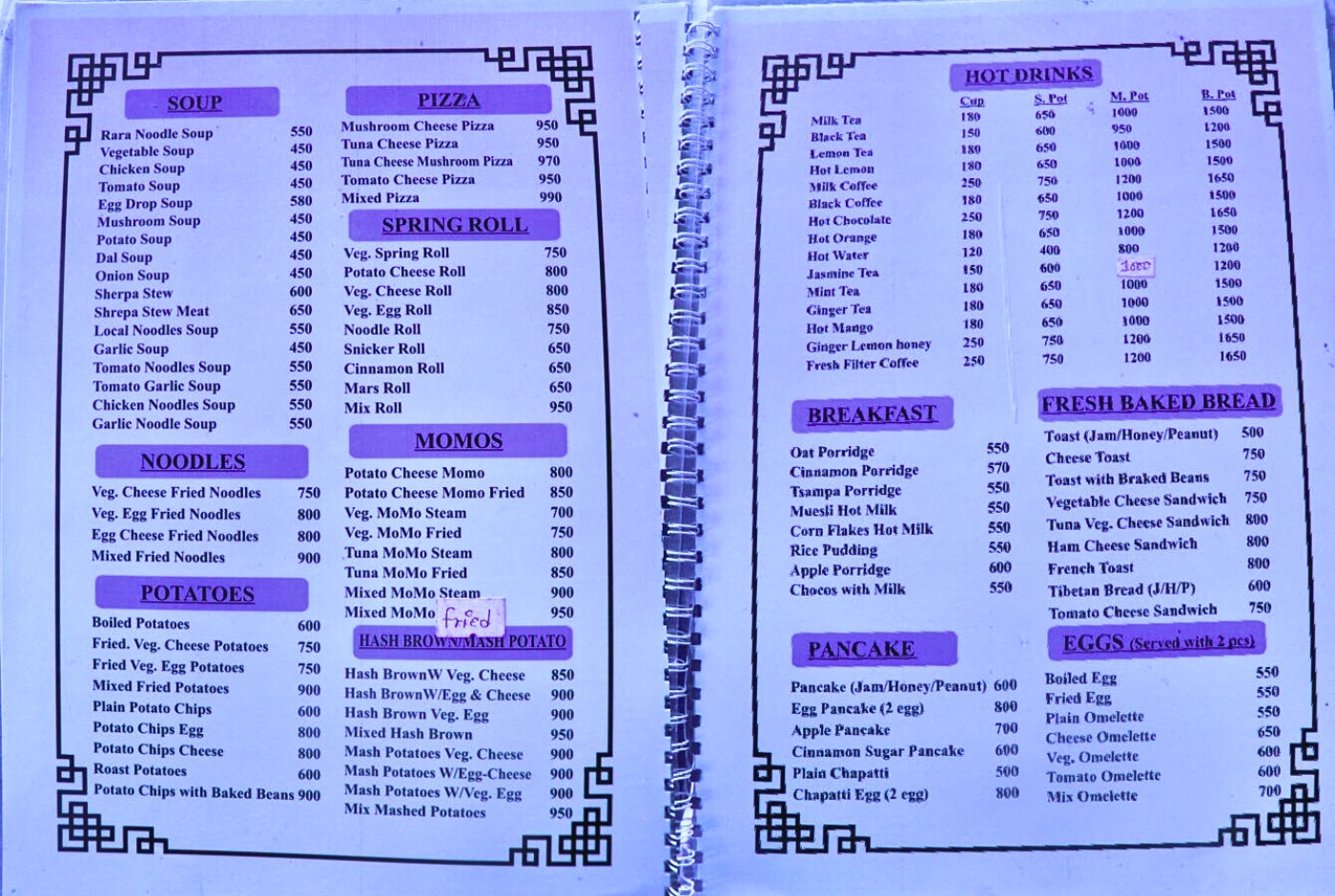
Breakfast
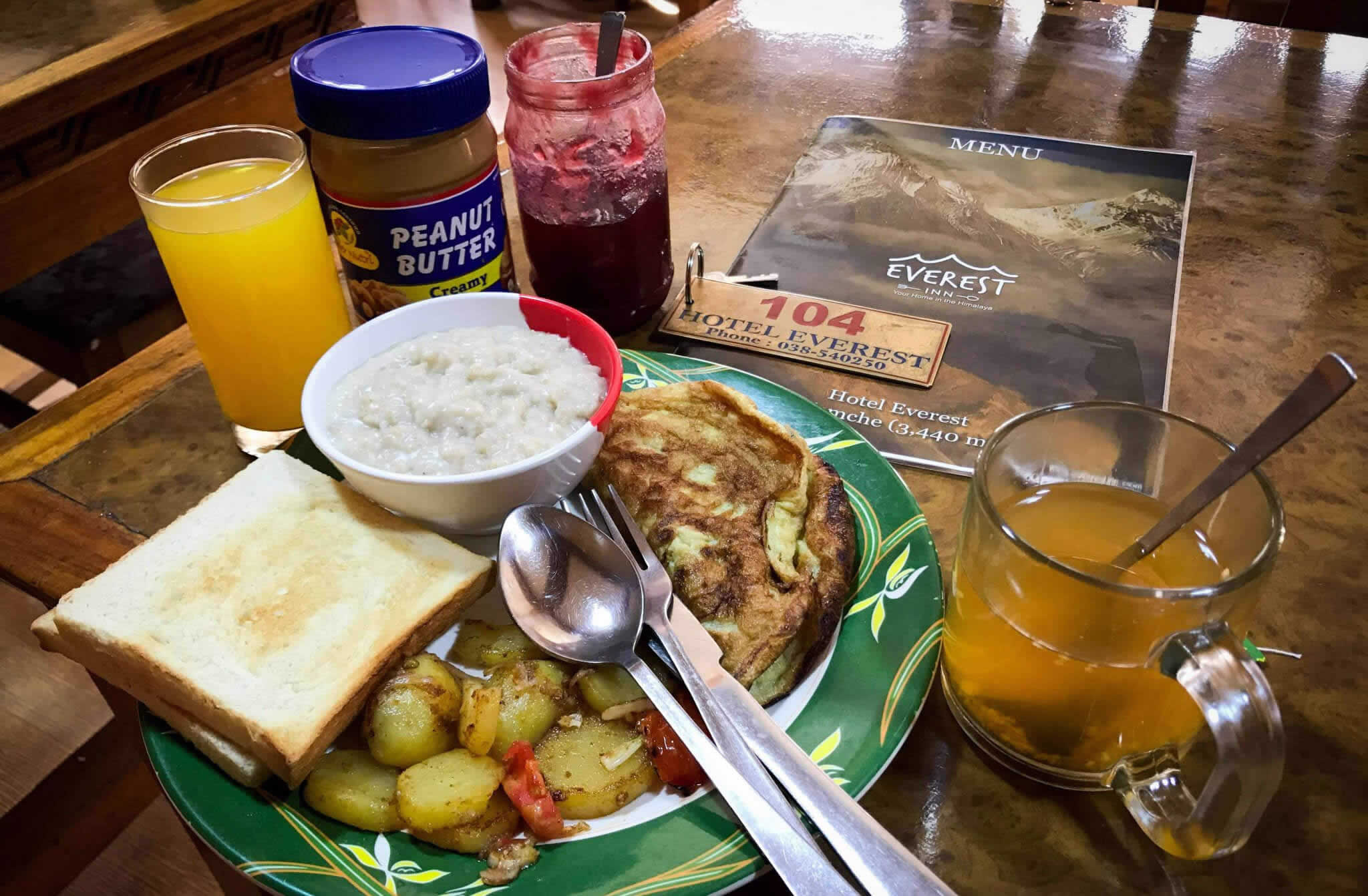
Early breakfast is provided at the lodges and the guesthouses while trekking. Usually, breakfast is served at around 8 or 9 in the morning, making it suitable to be ready for the trek at 10 to start. For breakfast, it is recommended to start with a large intake of fluids. Tea is served at the guesthouses and is a great way to fill up your body with warmth early in the morning. Many trekkers also prefer to take with them their own tea-bags or their best brand of coffee with them along the journey. Oatmeals are also the best option for breakfast, along with toasts served with jam, honey or butter. Chapatti Roti are also quite tasty to have with omelets. Meals such as pancakes and eggs done in various ways are also available for breakfast, along with some fruit juice. A healthy portion of oatmeal for breakfast results in your body being replenished for a longer amount of time and also to have a higher level of glucose in your bloodstream resulting in energy.
Lunch
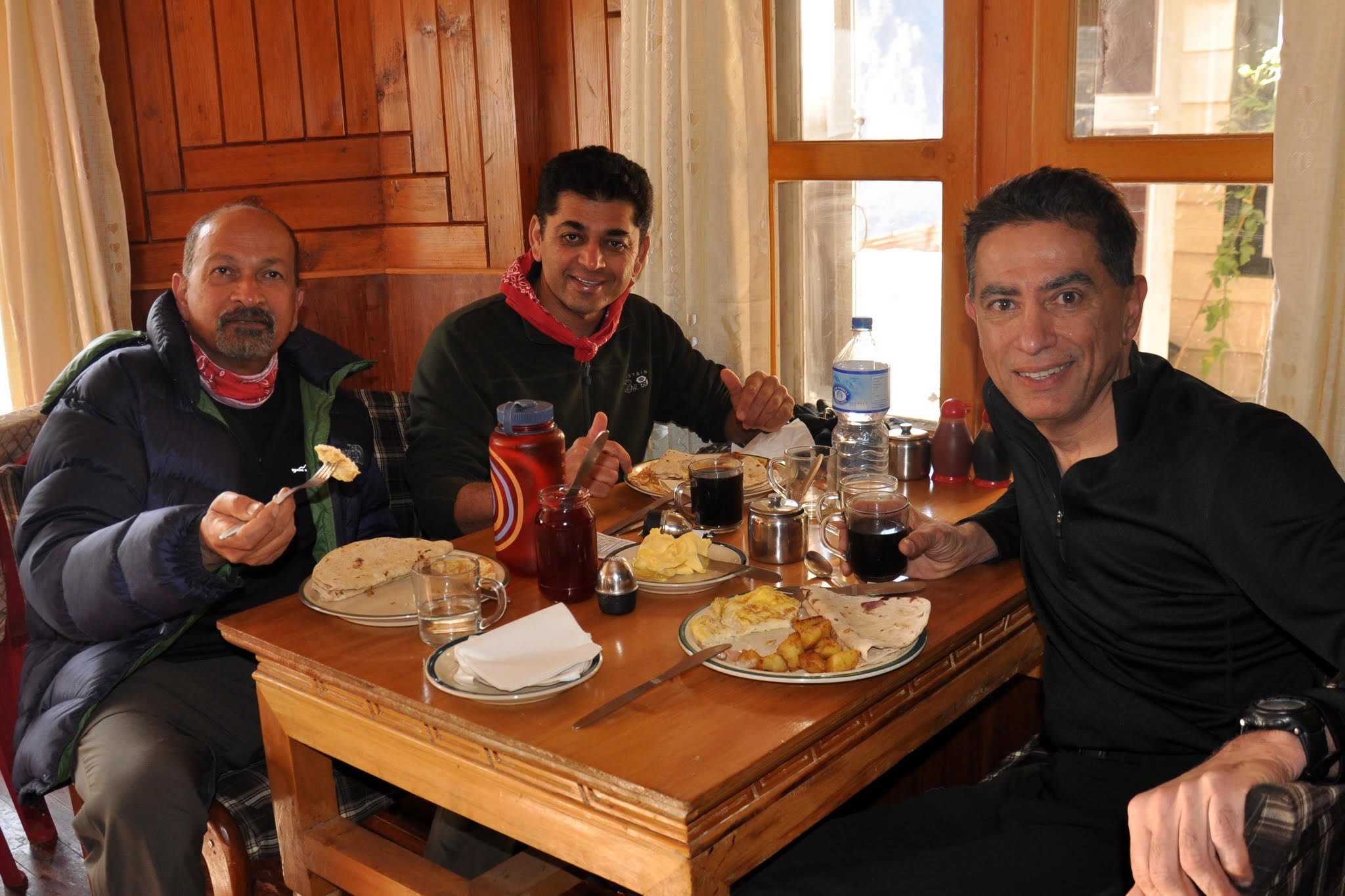
The selection of meals for lunch and food during the Everest Base Camp Trek has much variety ranging from simple snacks like Tibetan breads with jam to various vegetable and meat soups, sandwiches, dumplings with both vegetarian and non-vegetarian stuffing, pasta dishes and pizza. But nothing beats the nourishment factor and the zeal provided by Dal Bhat. Rice with vegetable curry, lentils and beans make for a heavenly meal during the trek. Garlic soups are also great for altitude sickness.
Dinner

Generally, trekkers sometime suffer from loss of appetite while trekking at high altitudes. But it is very important to keep your stomach full even if there’s loss of appetite as this will help in preventing altitude sickness and to keep your body healthy. Dinner meals are similar to lunch menus and choosing a replenishing dish for the night is a wholesome affair of local dumplings, noodles, pasta, spaghetti or porridge. Again, Rice and veggies are the kings of nourishing meals while trekking. As the sun sets rapidly amidst the mountain, trekkers tend to huddle around the dinner tables after their meals and spend the remainder of the time before bed drinking beer and tea and talking.
Drinking Water along the Everest Base Camp Trek journey

Drinking plenty of fluids during the trek is an important aspect of maintaining your body’s hydration level and to avoid altitude sickness. Around 3 to 4 liters of fluid is recommended for daily intake while trekking. The fluids include tea, soup or simple drinking water. Trekkers can opt for buying bottled drinking water from the shops in the mountains or use water-purifying tablets. The tap-waters in the mountains are not suitable for direct consumption, and thus using water-purifying tablets or other forms of water purification like pumps is recommended for drinking water consumption. Generally, using purifying tablets presents fewer hassles and does not pollute the environment like bottled water. The price of bottled water also varies at different locations, but generally the price of a liter of bottled water costs around NRs 150.
Authentic Nepali Teahouse Cuisine on the Everest Base Camp Trek
Dal Bhat: (Rice and Lentils)
Beyond the ubiquitous dal bhat, momos, and thukpa, tea houses serve hearty regional fare with local ingredients. Staples like rice and curry (dal bhat) remain, but the vegetable curries (“tarkari”) they come with change by season. For example, one guide notes that the mild vegetable curry in dal bhat “depends upon the season”– peas, cauliflowers or cabbages appear in summer and autumn, while root vegetables dominate in colder months. Meals are always garnished with spicy Nepali achaar (pickles) and papad (lentil crisps), and a bit of local yogurt or chutney. These sides brighten simple dishes with zing – from tangy tomato achar to fiery mustard pickles – and are often refilled at will with dal bhat. As one traveler noted, dal bhat comes with “a few helpings of… vegetables or pickles”, a nod to these essential condiments. Because fresh produce is limited higher up, many dishes rely on preserved items: dried potatoes, fermented greens, and yak dairy.
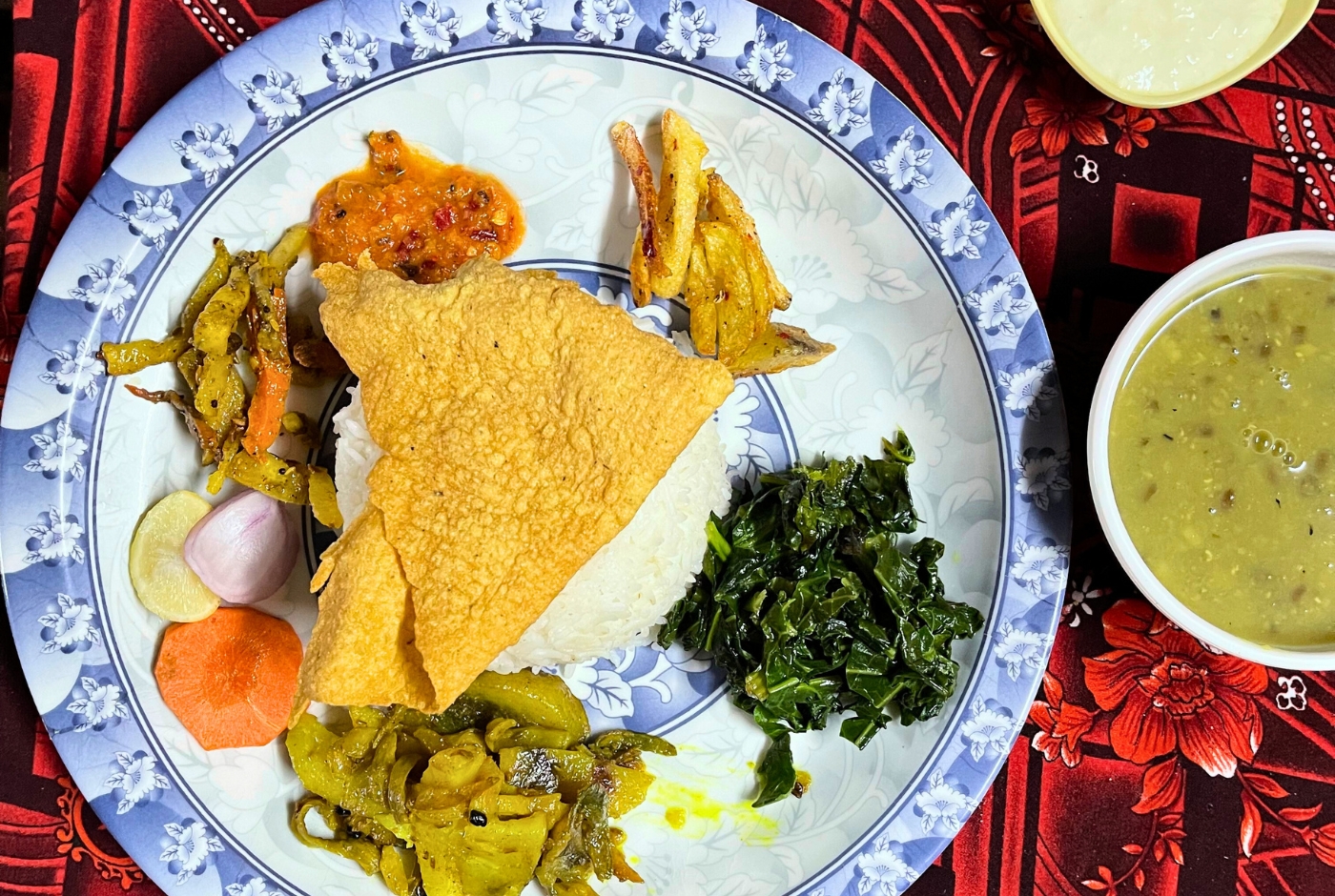
Tsampa: A perfect Breakfast
For Sherpa families in Khumbu, tsampa is a morning staple. Tsampa is roasted barley flour – often kneaded with yak butter tea or plain water into a dense porridge or dough ball – and is prized for sustained energy. Teahouse menus frequently list tsampa among breakfast choices, reflecting its Sherpa roots.
Riki Kur: Nepalese Pancake
Similarly, a potato pancake called Riki Kur (sometimes called a Sherpa pancake) is popular in high villages. Made from mashed potatoes and fried like a thick flatcake, Riki Kur is usually served with yak butter, local honey or cheese – making it rich and filling for vegans who add dairy or for omnivores.

Dhido: Lunch or Dinner; have it anytime.
Another hearty grain is dhido, a coarse porridge of buckwheat or millet flour that predates rice in Nepali history. Thick and doughy, dhido is often eaten with a ladle of gundruk curry or lentils.
Gundruk: Tangy but flavourful
Gurung and other mountain communities traditionally eat dhido with fermented gundruk (made from dried leafy greens), vegetable curries, pickles, or even yogurt (dahi). A cup of spicy gundruk soup (or gundruk achar) has a tangy, sour-salty bite; it’s fully vegetarian (in fact vegan) and a probiotic boost.
Sukuti
Dried meats also abound: most remote lodges carry sukuti (air‑dried spiced yak or buffalo jerky). Sikuti is intensely savory and usually meat-based. In contrast, the abundant vegetable stews and curries offer vegetarian and even vegan travelers plenty to eat – for example, plain rice, lentil daal and spiced vegetables can be paired freely for a filling plant-based meal.

Grains, Breads, and Sides
In Sherpa country, carbohydrates come in diverse forms. Besides rice, cheese tea (butter tea) and pancakes often appear at breakfast. Traditional Tibetan bread (sometimes called kur or tingmo) is a round, flat, slightly sweet fried or baked loaf, typically eaten hot with butter, jam or local honey.
Chapatis (whole‑wheat flatbreads) are also common, served with butter and honey at breakfast or alongside curries at lunch.
Simple porridges are ubiquitous too – oats, rice or millet porridge sweetened with honey or topped with dried fruit provide extra calories for cold mornings. Savory snacks round out meals. For instance, papad (crispy lentil wafers) and small popcorns are often offered at dinner time, a local tradition to nibble while waiting for the main course.
Fresh greens are rare in winter, but radish soup (made from pickled Himalayan radish) may be served in colder months as a warming vegetable soup. And in spring and summer, tea-house cooks sometimes forage wild greens: they might add sip-lag nettle or fern shoots to curries for a seasonal twist. (Indeed, chefs in the region note the use of Himalayan herbs like balm mint and young ferns in summer soups.) Traditional accompaniments are always available: a jar of sharp chili-garlic achar, or crushed timur (Sichuan pepper) mixed with salt, sits on the table to spice up a plain soup or potato dish. Together, these grains and sides reflect Nepali hospitality – generous, comforting, and adaptable to what the mountains provide.
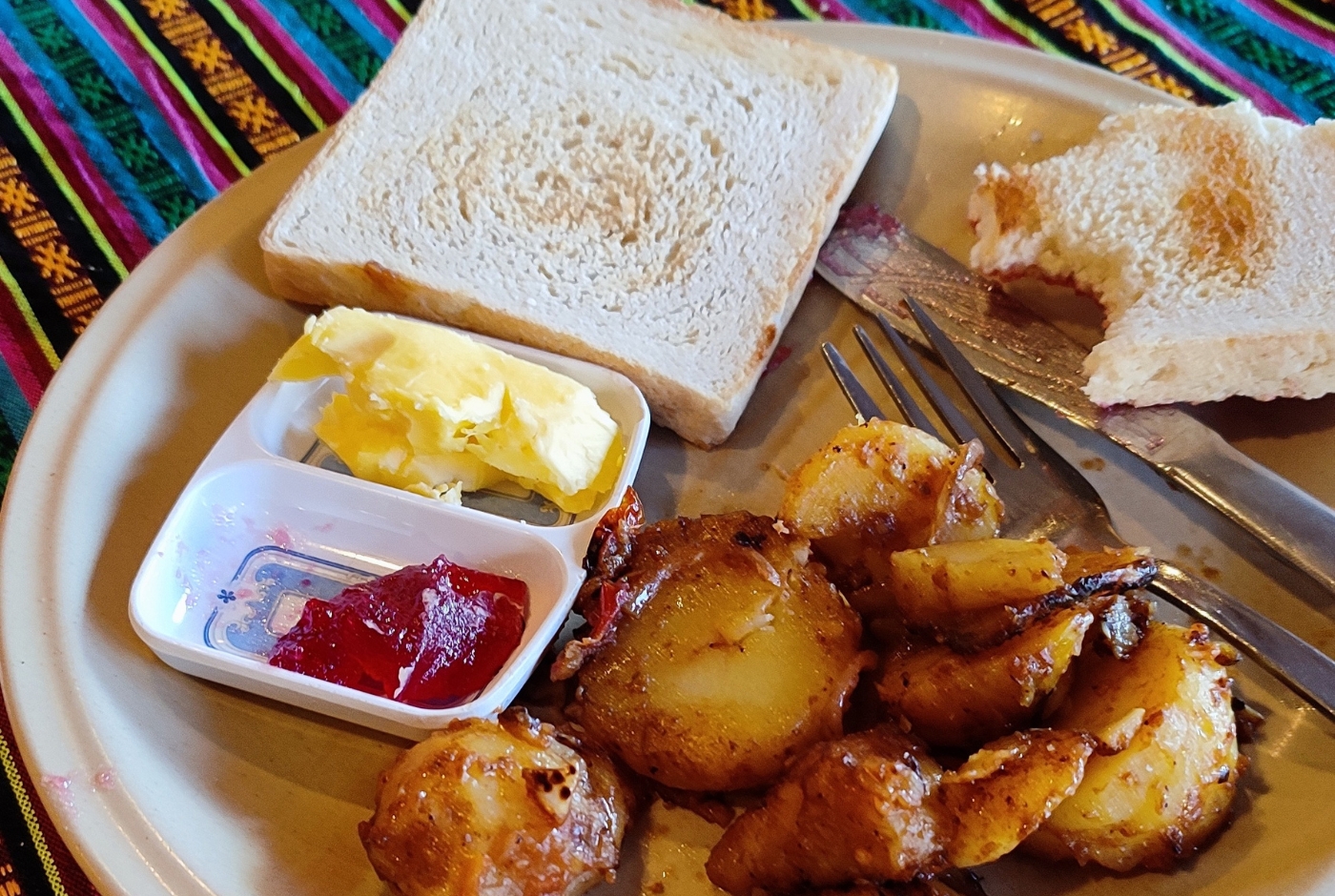
Soups, Stews, and Remedies
No trekker goes without hot soup, and Himalayan tea houses answer with many varieties. Apart from thukpa and noodle soups, a cornerstone is Sherpa stew (shyakpa) – a thick, nourishing noodle-and-vegetable soup often simmered with meat (yak or chicken) for flavor. Sherpa stew is sometimes simply called thukpa as well, but locals insist on calling it by the homely name “Sherpa Stew.” One description calls it a “flavorsome stew” with hand-pulled noodles, mixed veggies and optional yak or chicken, slow-cooked until savory. It is essentially the Khumbu equivalent of a restorative chicken soup – full of garlic, ginger, and spices – and suited to recovering energy after a long day.
For pure vegetarian comfort, thenthuk (hand‑pulled noodle soup with mountain greens or potatoes) is often available, as is gundruk soup (the fermented greens pureed into a warming broth).
Another famous remedy is garlic soup. This simple, clear broth loaded with minced garlic is offered on many menus as an “altitude remedy”. Hikers swear by it to stave off cold symptoms and aid acclimatization. It is vegan (just garlic, water or vegetable stock, and a pinch of salt) but surprisingly flavorful. A trek operator writes that garlic soup is “a simple but effective remedy for altitude sickness,” and notes that it provides hydration and warmth.
Likewise, hot ginger-lemon-honey tea is served on demand to soothe sore throats. In fact, many tea houses stock fresh ginger, salt and herbs so trekkers can order custom herbal broths – even turmeric tea or holy basil (tulsi) tea – mixed with a bit of yak butter for extra calories. These broths, along with the soups above, form a traditional Nepali pharmacy: natural, warming and comforting in thin mountain air.
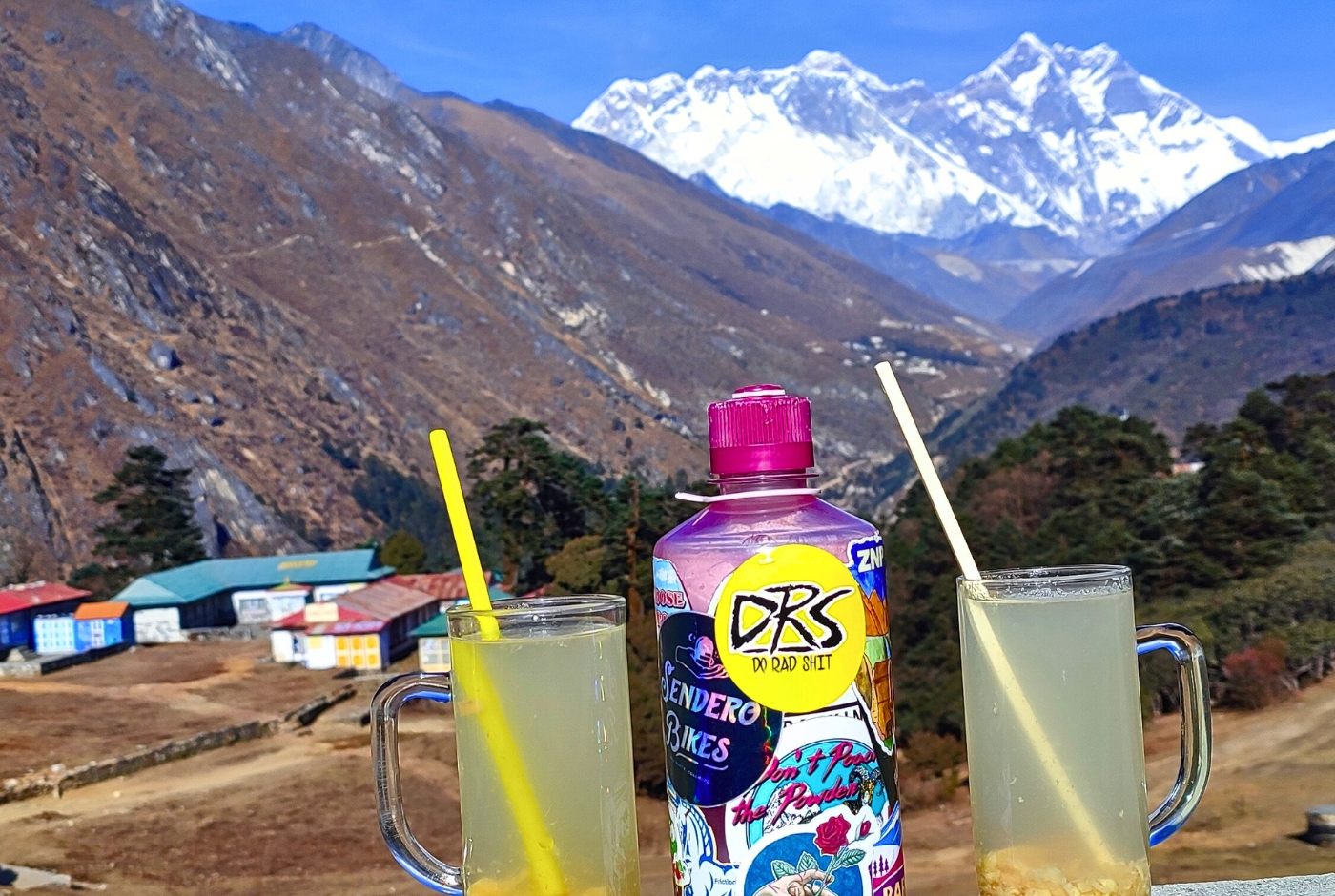
Beverages and Tradition
Butter Tea
No discussion of Everest foods is complete without butter tea. Every village in Khumbu has its variation of this milky brew. Made by vigorously churning strong tea with salted yak butter, it is intensely caloric and hydrating. Trekking guides note that “yak butter is another essential ingredient” and that butter tea is “highly valued for its warming and energizing properties” at altitude. First-timers may find the taste odd, but locals drink it in gallons to fuel long climbs.
Black Masala Chiya (Tea)
Besides butter tea, simple milky black tea (often sweetened or spiced with cardamom/ginger) is poured constantly throughout the day, and spiced masala tea or lemon-ginger tea is the favorite nightcap when electric lights are dim.
Hot Chocolate or Coffee? Try Nepalese beers and vodkas
At dinner, a steaming mug of spiced hot chocolate or coffee is sometimes requested, but classic Sherpa evenings often end with a glass of gurjo or chhaang – mild millet beers or sugarcane vodkas made in remote homesteads – as a cultural treat. In most tea houses, however, hot drinks are herbal or milky: black tea with milk, ginger-lemon-honey tea, and hot water with sugar is a norm. These drinks help conserve precious water (so often boiled, not bottled) and keep weary trekkers warm.
Seasonal and Highland Specialties
Because Khumbu’s climate is extreme, food culture here is shaped by seasons.
In summer and autumn, a wealth of produce arrives by mule: tomatoes, spinach, sweet corn, and even apples in Namche Bazaar. This allows veggie-heavy dishes and fruit salads in those months.
By contrast, winter menus are sparse, relying on stored staples and hardy greens. Fermented foods like gundruk and waltea greens are crucial in winter, and dried items (sukuti, dried pumpkin, etc.) reappear. Springtime brings more greens: foragers gather nettles, dhup (wild garlic) or urida (fern shoots) to cook with lentils. Everest Cuisine chefs even mention using chiraito (Himalayan mint) and wild mushrooms when available – for example, nigurio mushrooms are foraged during the monsoon and briefly pan-fried for their rich umami.
These seasonal foraged ingredients, while not guaranteed on every menu, occasionally flavor special stews or thukpas. In short, the high villages of Khumbu eat as the land allows. Meals are kept simple and nourishing: buckwheats and rices, mountain potatoes, barley, greens, and plenty of dairy or meat protein from yaks and poultry.
Religious and cultural traditions also appear – for instance, a festive sel roti (sweet fried rice doughnut) may show up on Dashain, or locally brewed tongba (fermented millet beer) after a successful climb – but the day-to-day trek fare stays humble and practical.
The diversity of dishes – from fermented gundruk curry to yak butter tea – reflects centuries of adaptation to the Himalayas. For a traveler, the reward is an authentic taste of Sherpa hospitality: bowls of flavor that quietly rebuild body and spirit with every mile climbed.
Western-style dishes on the Everest Base Camp trek
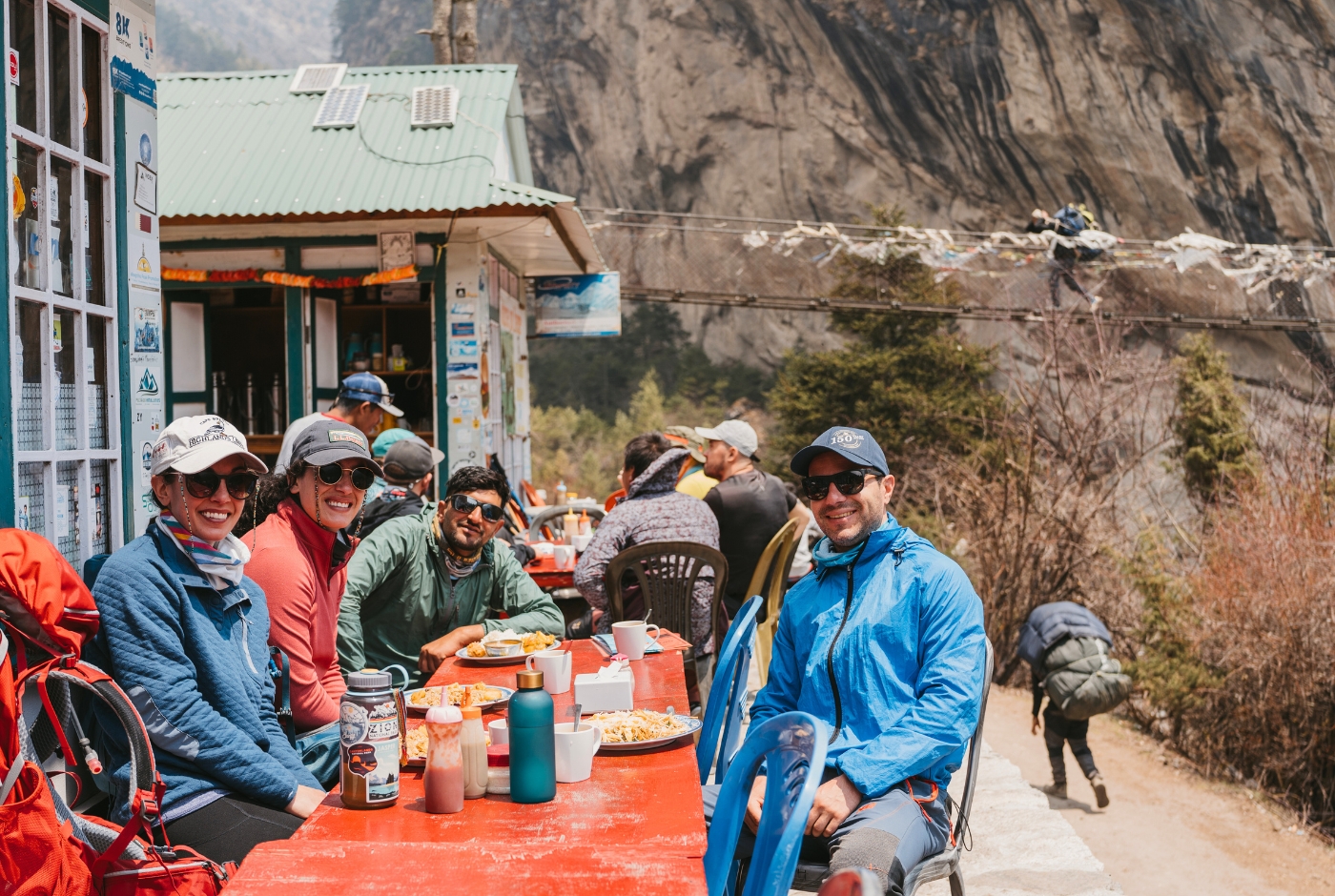
- Spaghetti: A simple pasta dish of long noodles usually tossed in a tomato-based sauce and topped with melted cheese. It is often served plain or with added tuna or vegetables to give a familiar Western flavor.
- Pizza: A flat round bread topped with tomato and a layer of melted cheese, often with a few basic toppings like vegetables, egg or pieces of meat. These pizzas are baked in local teahouses and typically feature simple toppings (for example, a Margherita style with tomato and cheese)
- Macaroni: Short tubular pasta that arrives in a creamy cheese sauce or a light tomato sauce. Local teahouses often serve macaroni mixed with cheese (and sometimes a fried egg or vegetables), making it a hearty, familiar meal for trekkers.
- Sandwiches: Toasted or grilled bread sandwiches filled with Nepali-style ingredients. Common fillings include sliced tomato and cheese, egg, or tuna, and they are usually served with a side of fries (often called “chips” in menus). These simple grilled sandwiches provide a quick and filling Western-style lunch or snack.
- Burgers: Burger sandwiches made with a bun and a patty (often chicken or a vegetable patty), typically served with French fries. The buns may be stuffed with a fried chicken fillet or a cheese-filled patty and lettuce/tomato, giving trekkers a familiar home-style burger meal even at high altitude.
- Pancakes: Fluffy, sweet pancakes (often called “American pancakes” on menus) served hot for breakfast. They are made from a simple batter (flour, egg, milk) and usually topped with a spoonful of jam, honey, or sometimes fruit, making a sweet start to the day.
- French toast: Slices of bread dipped in beaten egg and pan-fried until golden. The bread is then served warm with toppings like butter, jam, or honey. This Western-style breakfast item is often listed simply as “French toast” on teahouse menus.
- Omelettes: Beaten eggs cooked into a flat or folded cake, often mixed with ingredients like diced tomato, onion, or cheese. These hearty egg omelettes are a popular breakfast choice and are usually served with buttered toast or flatbread on the side.
Tips for Eating on the Trek
- Hydration is Key: Drink plenty of water throughout the day, as altitude can dehydrate you even if you don't feel thirsty. Consider adding electrolyte tablets to your water for better hydration.
- Small, Frequent Meals: Instead of large meals, eat small, frequent snacks to maintain energy levels and aid digestion.
- High-Calorie, Nutrient-Dense Foods: Focus on foods that provide sustained energy and are packed with nutrients.
- Local Specialties: Dal Bhat is a staple and provides balanced nutrients. Try other local dishes to experience the regional cuisine.
- Food Safety: Avoid raw vegetables, salads, and unpeeled fruits to minimize the risk of foodborne illness.
- Meat Considerations: Meat on the trek is not refrigerated and may not be fresh, so it's best to avoid it.
- Snacks: Pack energy bars, trail mix, dried fruits, nuts, and chocolates for a quick energy boost.
- Limit Alcohol and Caffeine: These can contribute to dehydration and affect acclimatization
- Teahouse Selection: Choose busy teahouses where food is likely to be fresher.
The food during the Everest Base Camp Trek plays an important role in making the journey pleasing. Preparing your body for the trek is also important. Relatively, it does depend upon the person and the body’s capabilities. Having a good physical condition and a good stamina level also play a part in making the trekking journey memorable.
